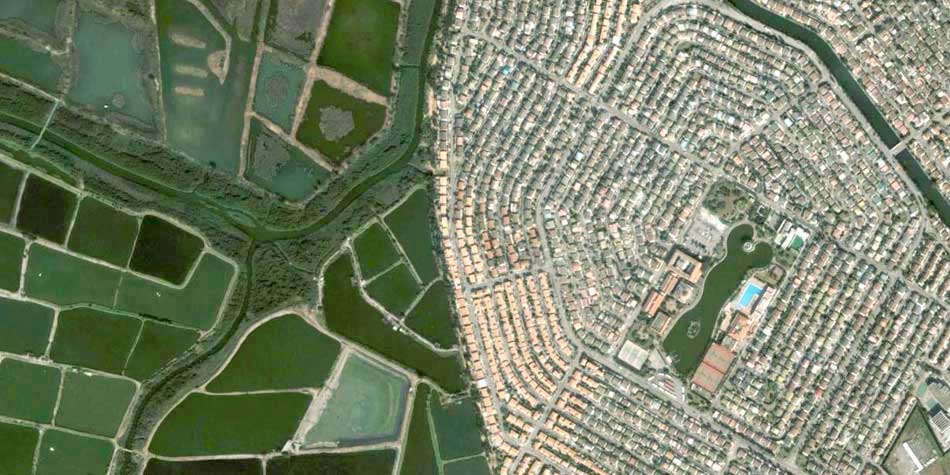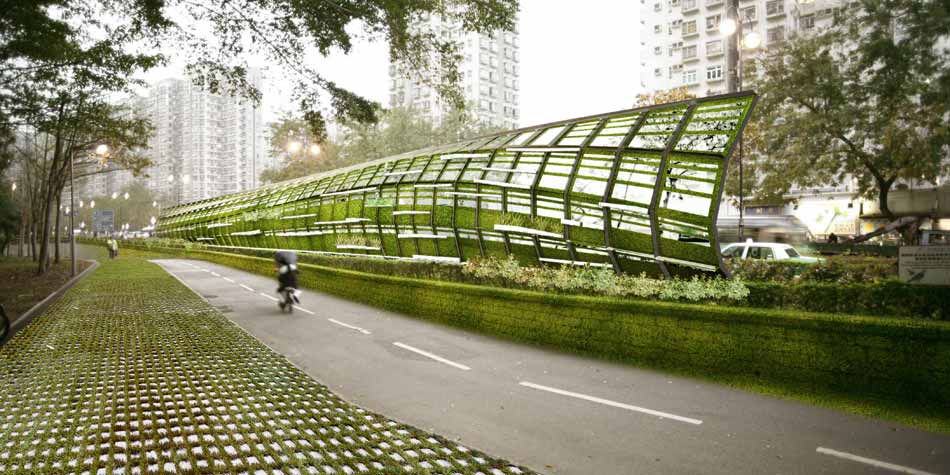LINEAR LANDSCAPES: FABRICATING A RURAL/URBAN INTERFACE
Transportation infrastructure accounts for 5% of all land in Hong Kong, occupying a significant amount of territory within the urban areas of the city. Although 90% of the HKSAR is vegetation, the green areas remain disconnected from daily city life, becoming invisible in the residential and commercial regions. The paradox of Hong Kong is that we are surrounded by nature but we never see it. In order to remedy this we propose to camouflage the highways with vegetation in order to erase them, softening the boundary between the natural and the concrete. In this proposal we intervene by appropriating the interstitial space, utilizing nature to cut energy costs while also lowering the ambient air temperature, reducing the air pollution along with the noise pollution. Tended by a new generation of urban botanists and organic farmers, the local plants will entwine with the existing landscape, forming a second skin for the highways. We propose an updated ‘Commons’, a public space for one to grow everyday herbs and edible plants to be harvested on a daily basis. Our proposal will provide fruit and vegetables such as eggplant, avocado, pak choi, snow peas, and sweet potato that grow naturally and locally. Unlike items such as ‘globe’ tomatoes – the standard supermarket tomato of international commerce – our cultivars need not be modified with thicker, waxier, hyper-resilient skins to ensure their survival during travel. Our fruit is provided at arm’s reach, not via the cargo hold of a 747: these plant roots are suspended over a steady mist of rain water, not entrenched in the earth several continents away. The shallow roots develop only to the minimum depth necessary to suck in nutrients from a feeder tube – a computer controlled pipeline that keeps them alive, happily growing day and night underneath the high pressure sodium street lamps. The vegetation forms the architecture, blurring the boundary of ‘natural’ building materials. Our materials are not just ‘green’, they are still alive.
The proposal is to build only with recycled material. By designing the noise barrier to act as a communication device, the barrier becomes a new form of highway billboard, actively promoting programs that reduce the need for additional landfills. Local material collected specifically for the project will go on to take a visible presence in the final project: one project material is made entirely from discarded milk and detergent packaging and another ecoglass is a 40% post-industrial recycled material. Although the entire façade is constructed from the throw-away residues of our consumption, it has been painstakingly transformed into a highly engineered, serviceable and overtly intelligent product; allowing us to be elegantly enveloped in our own refuse.
Alongside the public paths we propose to grow vegetables, while the traffic side would be planted with pollution eating plants. Seeking a carbon neutral solution, we intend to offset the CO2 required to construct the project with the carbon sequestration offered by the additional vegetation. The barrier provides other indicators of nature: shade and sun plants indicate orientation, growth cycles subtly indicate the seasons. A fire suppression system embedded in the design doubles as the sprinkler system that waters the plants. The plants are intrinsically graffiti proof, if sprayed the façade simply grows back. However, graffiti artists could be actively invited to design with the plants, by sowing seed, not spray paint. Lastly, the project provides an urban habitat for the birds; instead of colliding into the transparent panels of the existing noise barriers, we provide nests to encourage them to move back into the metropolis.
Acknowledgment/ Team Credits:
Designers: Eric Schuldenfrei and Marisa Yiu
Project Team: Eric Schuldenfrei, Marisa Yiu, Vanir Chan, Kin Cheong Chan
This project was awarded 3rd prize in the professional category of the Noise Barrier / Noise Enclosure Design Competition. The competition was jointly organized by the Highways Department, the Environmental Protection Department, The Hong Kong Institute of Architects, The Hong Kong Institution of Engineers, The Hong Kong Institution of Highways and Transportation and The Hong Kong Institute of Landscape Architects.










